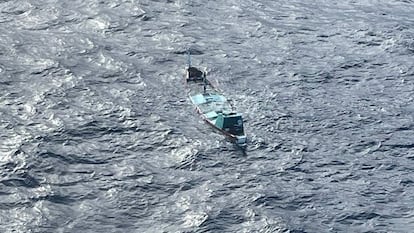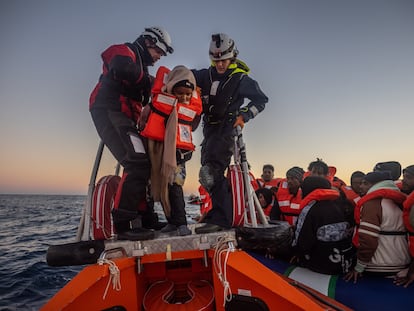The incredible odyssey of nine castaways attempting to reach Europe
A migrant boat with an inexperienced skipper left from Senegal and capsized in the Atlantic, leaving over 50 passengers dead, but nine survivors managed to change course and await rescue

Another tragedy in the Atlantic has left a new trail of people dead while attempting to reach Europe, but it is also an extraordinary story of survival. Early last Monday, a 230-meter tanker sighted a semi-submerged flat-bottomed boat in which nine exhausted men were holding on. They were rescued by a Spanish Coast Guard helicopter and the initial accounts they gave to authorities on reaching land described an incredible odyssey. The boat, with 60 people on board when it set sail, capsized and the nine castaways managed to turn it back around and keep it afloat for several hours. The story raised the suspicions of the police, among other reasons because it was a sizeable boat and therefore difficult to turn on the open sea, but after taking statements from six of the nine survivors, the pieces fit together. “The testimonies are coincidental and spontaneous. In other words, they are credible,” explains a police source.
The boat left the fishing village of M’bour in Senegal in the early hours of April 18. This area was the epicenter of migrant departures in boats bound for the Canary Islands — an archipelago off the western coast of Africa that is part of Spain — at the end of 2020, but the exodus from this area of Senegal had started to wane a few months ago. On board this boat, said the survivors, were 60 people including four minors. Compared to others that have arrived in the Spanish archipelago in recent months, carrying up to 300 people, this one was not overloaded to such an extent and had plenty of fuel and food. The water, however, ran out, and the passengers soon realized they were being steered by a skipper with little sailing expertise, the survivors told police.
Ten days after their departure, by which time they should have been able to reach any of the Canary Islands, the boat destabilized and capsized to the starboard (right) side at around 5 p.m. on April 28. It is not clear what caused the problem, but the castaways put forward several reasons that could have combined at the same time. A gust of wind, a wave, and a bad load, i.e., the weight of the passengers was unbalanced, causing the boat to tilt. Above all, according to police sources, the survivors pointed to the “lack of skill” of the skipper to address the situation.
When the boat capsized, the passengers all fell into the water. Those rescued say that the skipper was the first to die because he hit the propellers on the engine. Almost everyone drowned, including the brother of one of the survivors. The toll of 51 added to the 179 dead or missing people that the International Organization for Migration (IOM) has verified so far this year in the Atlantic. The IOM is aware that its figures are much lower than the reality, “but it is a route where it is difficult to find firm evidence of all shipwrecks,” says Flavio Di Giacomo, spokesman for this UN-dependent agency. An example of this is the recent discovery in Brazil of a boat carrying nine decomposing bodies — migrants from Mauritania and Mali — a reminder of the dozens of boats that are lost every year trying to reach Europe. The journey to the Canary Islands is one of the most dangerous migratory routes in the world.
What is extraordinary is how these nine men managed to survive the chaos of a shipwreck and to then to change the course of a boat that, although it was made of wood and had a lot of buoyancy, weighed several tons. They did not provide many details, but all six of the rescued men stated that they managed to turn it around and climbed onto the half-sunken wreckage. They held on until the crew of the oil tanker Beskidy, on its way to Cartagena, Spain, sighted them at about 7 a.m. on April 29, some 60 nautical miles (111 kilometers) from the Canary Island of El Hierro. According to their account they did not spend two days on the wrecked boat as initially reported, but over 12 hours including a full night.
The Beskidy sent out a radio SOS and the Spanish Coast guard vessel Adhara set off to search for them immediately. Two hours later they were located by a helicopter and evacuated to the mainland. Last Wednesday, six of those rescued were still in hospital, although according to medical sources their lives are not in danger.

The Canary Islands route has attracted a lot of attention in recent months, especially since October when there was a huge increase in the number of arrivals, especially on the island of El Hierro. The headlines continue to point to a spike in arrivals and although compared to last year’s figures that is the case, there are nuances because although remaining high the numbers of people landing in the Canaries have been declining for two months.
Up to April 29, 15,773 migrants and refugees had landed in the Canary Islands, according to the IOM, compared to 3,000 in the same period last year. It is a significant increase but after the peak that began in October 2023 and lasted until mid-February, the figures for March and April have dropped considerably compared to previous months.
Even so, the islands are experiencing an unprecedented period of immigration activity. There were around 40,000 arrivals in 2023 and, despite the recent slowdown, the numbers of people being rescued are in the thousands during months of the year in which this route has traditionally seen no activity.
Sign up for our weekly newsletter to get more English-language news coverage from EL PAÍS USA Edition
Tu suscripción se está usando en otro dispositivo
¿Quieres añadir otro usuario a tu suscripción?
Si continúas leyendo en este dispositivo, no se podrá leer en el otro.
FlechaTu suscripción se está usando en otro dispositivo y solo puedes acceder a EL PAÍS desde un dispositivo a la vez.
Si quieres compartir tu cuenta, cambia tu suscripción a la modalidad Premium, así podrás añadir otro usuario. Cada uno accederá con su propia cuenta de email, lo que os permitirá personalizar vuestra experiencia en EL PAÍS.
¿Tienes una suscripción de empresa? Accede aquí para contratar más cuentas.
En el caso de no saber quién está usando tu cuenta, te recomendamos cambiar tu contraseña aquí.
Si decides continuar compartiendo tu cuenta, este mensaje se mostrará en tu dispositivo y en el de la otra persona que está usando tu cuenta de forma indefinida, afectando a tu experiencia de lectura. Puedes consultar aquí los términos y condiciones de la suscripción digital.
More information

Why is there a new surge in migrant boats to Spain’s Canary Islands?
Archived In
Últimas noticias
Tiger Woods turns 50: Will he continue playing on the PGA Tour or take a back seat?
The surreal journey of James Nnaji, the Barcelona youth player selected in the NBA Draft who ended up in the NCAA
Trump claims peace in Ukraine is near, but Moscow suggests otherwise
A survivor’s account of the Interoceanic Train accident: ‘We were scared because of the speed on the curve’
Most viewed
- Oona Chaplin: ‘I told James Cameron that I was living in a treehouse and starting a permaculture project with a friend’
- Reinhard Genzel, Nobel laureate in physics: ‘One-minute videos will never give you the truth’
- Sinaloa Cartel war is taking its toll on Los Chapitos
- Why the price of coffee has skyrocketed: from Brazilian plantations to specialty coffee houses
- Chevy Chase, the beloved comedian who was a monster off camera: ‘Not everyone hated him, just the people who’ve worked with him’










































